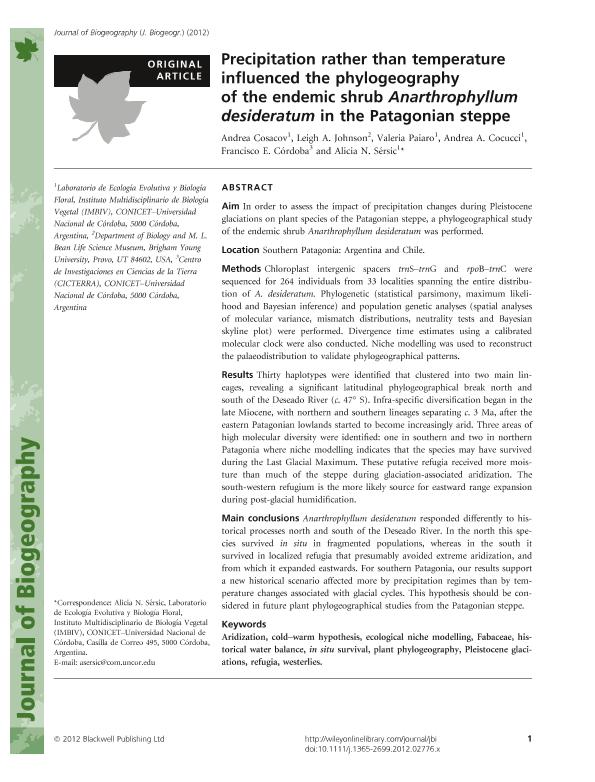Artículo
Precipitation rather than temperature imprinted the phylogeography of the endemic shrub Anarthrophyllum desideratum in the Patagonian steppe
Cosacov Martinez, Andrea ; Johnson, Leigh A.; Paiaro, Valeria
; Johnson, Leigh A.; Paiaro, Valeria ; Cocucci, Andrea Aristides
; Cocucci, Andrea Aristides ; Cordoba, Francisco Elizalde
; Cordoba, Francisco Elizalde ; Sersic, Alicia Noemi
; Sersic, Alicia Noemi
 ; Johnson, Leigh A.; Paiaro, Valeria
; Johnson, Leigh A.; Paiaro, Valeria ; Cocucci, Andrea Aristides
; Cocucci, Andrea Aristides ; Cordoba, Francisco Elizalde
; Cordoba, Francisco Elizalde ; Sersic, Alicia Noemi
; Sersic, Alicia Noemi
Fecha de publicación:
06/2012
Editorial:
Wiley Blackwell Publishing, Inc
Revista:
Journal Of Biogeography
ISSN:
0305-0270
Idioma:
Inglés
Tipo de recurso:
Artículo publicado
Clasificación temática:
Resumen
Aim In order to assess the impact of precipitation changes during Pleistocene glaciations on plant species of the Patagonian steppe, a phylogeographical study of the endemic shrub Anarthrophyllum desideratum was performed. Location Southern Patagonia: Argentina and Chile. Methods Chloroplast intergenic spacers trnS?trnG and rpoB?trnC were sequenced for 264 individuals from 33 localities spanning the entire distribution of A. desideratum. Phylogenetic (statistical parsimony, maximum likelihood and Bayesian inference) and population genetic analyses (spatial analyses of molecular variance, mismatch distributions, neutrality tests and Bayesian skyline plot) were performed. Divergence time estimates using a calibrated molecular clock were also conducted. Niche modelling was used to reconstruct the palaeodistribution to validate phylogeographical patterns. Results Thirty haplotypes were identified that clustered into two main lineages, revealing a significant latitudinal phylogeographical break north and south of the Deseado River (c.47°S). Infra-specific diversification began in the late Miocene, with northern and southern lineages separating c. 3 Ma, after the eastern Patagonian lowlands started to become increasingly arid. Three areas of high molecular diversity were identified: one in southern and two in northern Patagonia where niche modelling indicates that the species may have survived during the Last Glacial Maximum. These putative refugia received more moisture than much of the steppe during glaciation-associated aridization. The south-western refugium is the more likely source for eastward range expansion during post-glacial humidification. Main conclusions Anarthrophyllum desideratum responded differently to historical processes north and south of the Deseado River. In the north this species survived in situ in fragmented populations, whereas in the south it survived in localized refugia that presumably avoided extreme aridization, and from which it expanded eastwards. For southern Patagonia, our results support a new historical scenario affected more by precipitation regimes than by temperature changes associated with glacial cycles. This hypothesis should be considered in future plant phylogeographical studies from the Patagonian steppe. Keywords Aridization, cold?warm hypothesis, ecological niche modelling, Fabaceae, historical water balance, in situ survival, plant phylogeography, Pleistocene glaciations, refugia, westerlies.
Palabras clave:
Patagonia
,
Legume
,
Evolution
,
Climate
Archivos asociados
Licencia
Identificadores
Colecciones
Articulos(CICTERRA)
Articulos de CENTRO DE INVEST.EN CS.DE LA TIERRA
Articulos de CENTRO DE INVEST.EN CS.DE LA TIERRA
Articulos(IMBIV)
Articulos de INST.MULTIDISCIPL.DE BIOLOGIA VEGETAL (P)
Articulos de INST.MULTIDISCIPL.DE BIOLOGIA VEGETAL (P)
Citación
Cosacov Martinez, Andrea; Johnson, Leigh A.; Paiaro, Valeria; Cocucci, Andrea Aristides; Cordoba, Francisco Elizalde; et al.; Precipitation rather than temperature imprinted the phylogeography of the endemic shrub Anarthrophyllum desideratum in the Patagonian steppe; Wiley Blackwell Publishing, Inc; Journal Of Biogeography; 40; 1; 6-2012; 168-182
Compartir
Altmétricas



